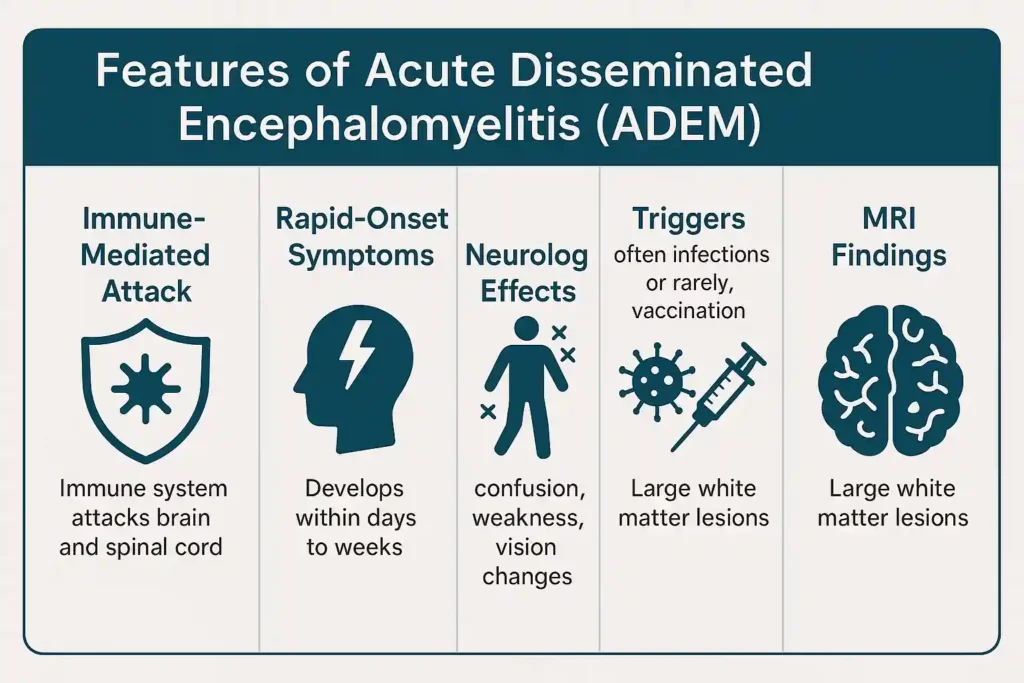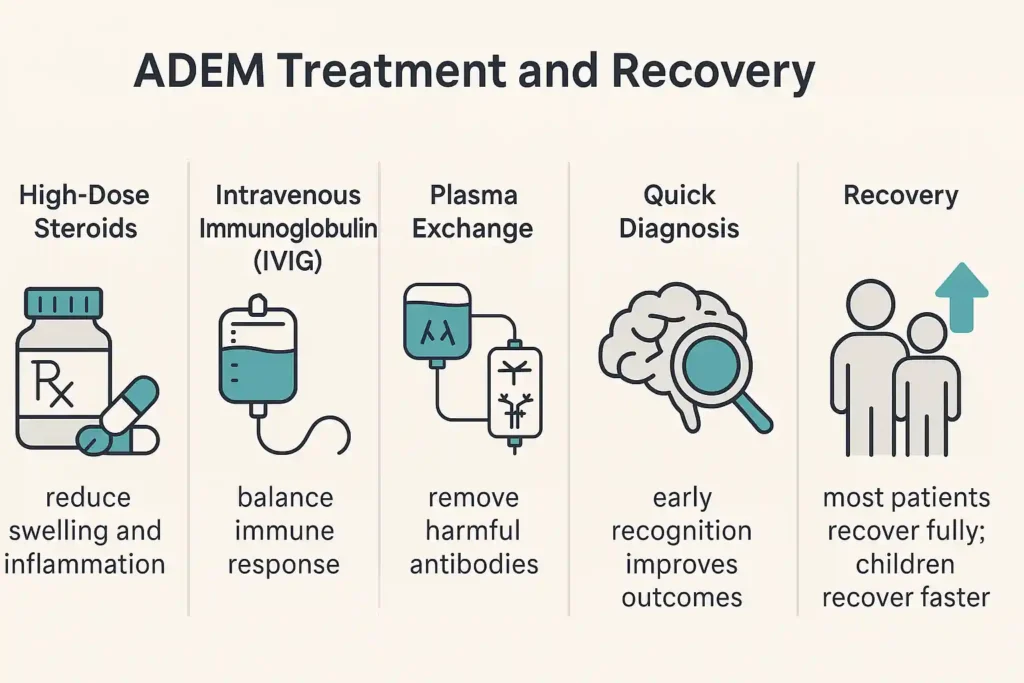Table of Contents
ToggleOverview
What is acute disseminated encephalomyelitis (ADEM)?
Acute disseminated encephalomyelitis is a sudden neurological condition that affects the brain and spinal cord. It causes swelling and damage to the protective covering of nerve fibers called myelin. When myelin breaks down, messages between the brain and the body get disrupted. This condition is classified as an immune-mediated neurological disorder.
Doctors believe the immune system becomes confused after fighting an infection. Instead of stopping once the infection is gone, the immune system starts attacking healthy brain and spinal cord tissue. This creates a burst of inflammation and results in demyelination of brain and spinal cord.
Many people ask, what is acute disseminated encephalomyelitis compared to multiple sclerosis (MS)? The difference is that ADEM usually happens as a single episode, while MS is a chronic, recurring disease.
How common is ADEM?
ADEM disease is rare. In children, it is more frequent than in adults. Typically, around 1 in 125,000 to 1 in 250,000 people are affected by ADEM each year. Boys are slightly more likely to be affected than girls.
It typically appears after viral infections such as measles, influenza, or Epstein-Barr virus. Although uncommon, post-vaccination ADEM has been reported. Because ADEM is rare, doctors often must rule out other conditions like MS, brain tumors, or severe infections before confirming the diagnosis.
Symptoms and Causes
What are the symptoms of ADEM?
The ADEM symptoms usually appear quickly, within days to weeks after an infection. They vary depending on which parts of the brain or spinal cord are inflamed. Common symptoms include:
- Fever, fatigue, and headache
- Confusion, irritability, or drowsiness
- Seizures
- Vision problems, such as blurred or double vision
- Muscle weakness in arms or legs
- Loss of coordination and balance
- Trouble speaking or slurred speech
- Numbness or tingling in the body
In children, behavioral changes such as sudden aggression or extreme sleepiness can also appear. Severe cases may even lead to coma.
What causes ADEM?
ADEM disease is thought to happen after the immune system overreacts to an infection. Viral and bacterial infections serve as the primary triggers. Once the infection is resolved, the immune system mistakenly persists in attacking healthy nerve tissue. This causes central nervous system inflammation.
In very rare cases, ADEM can follow vaccination. This is why the term post-vaccination ADEM exists, but the risk is extremely low compared to the benefits of vaccines.
What are the risk factors for ADEM?
- Age: Children are most affected, usually under 10 years.
- Recent infections: Cold, flu, or childhood illnesses such as measles or chickenpox.
- Genetics: A family history of neurological autoimmune disorders may raise the risk.
- Weakened immunity: People recovering from illness or those with compromised immune systems may be more vulnerable.
What are the complications of ADEM?
Complications can be mild or severe. Some patients recover fully, while others may face long-term effects. Possible complications include:
- Memory problems or slowed thinking
- Ongoing weakness or poor coordination
- Vision loss in one or both eyes
- Recurrence or relapse of ADEM (though rare, seen in 10–15% of cases)
- Confusion with other disorders such as multiple sclerosis
Diagnosis and Tests
How is ADEM diagnosed?
Because ADEM symptoms look like many other brain disorders, doctors must carefully rule out infections, strokes, and multiple sclerosis. A full ADEM diagnosis includes:
- Detailed medical history (recent infections, vaccines, family history)
- Neurological exam (testing reflexes, speech, balance, memory)
- Imaging tests like MRI
- Blood tests to rule out infections
- Spinal fluid analysis
ADEM on MRI
The most important tool for diagnosis is a brain MRI for ADEM. It often shows large, white spots scattered across the brain’s white matter, sometimes involving the spinal cord. These spots represent areas of demyelination. Unlike multiple sclerosis, which tends to show smaller and more frequent lesions, ADEM lesions are usually larger and appear all at once.
Spinal fluid testing
A spinal tap may also be conducted to evaluate for inflammation within the central nervous system. Doctors look for proteins and immune cells that suggest inflammation. This helps confirm the diagnosis and rule out viral meningitis or bacterial infections.
Management and Treatment
How is ADEM treated?
The main ADEM treatment is high-dose intravenous corticosteroids. This steroid therapy for ADEM reduces swelling and calms the immune system.
If steroids do not work, doctors may use:
- Plasma exchange (plasmapheresis): This method filters out detrimental antibodies from the blood.
- Intravenous immunoglobulin (IVIG): Provides healthy antibodies to balance the immune system.
Treatment is usually started right away because delays may lead to worse outcomes.
Are there side effects of the treatment?
Short-term steroid use may cause:
- Mood changes
- Increased appetite
- Trouble sleeping
- Higher blood sugar
- Stomach upset
Since therapy is short, these effects usually disappear after treatment ends.
How soon after treatment will I feel better?
Most patients start feeling better within a week of beginning steroids. Recovery can extend over several weeks to months. Children tend to recover faster than adults. Severe cases may take longer.
Outlook / Prognosis
What is the outlook for ADEM?
Most people recover fully from ADEM disease. Around 60–90% of patients return to normal health with no lasting problems. Children often recover better than adults.
What is the survival rate of ADEM?
The survival rate is very high—over 90%. Death is rare and usually only seen in severe cases where breathing centers in the brain are affected.
Is ADEM curable?
Yes. For most patients, ADEM is a single-time illness. With proper ADEM treatment, people often recover completely. In some cases, ADEM may be confused with multiple sclerosis, which is not curable but manageable. Careful follow-up is needed to make sure symptoms do not return.
Prevention
Can ADEM be prevented?
There is no specific way to prevent ADEM. But keeping good overall health helps. Steps include:
- Practicing good hygiene to avoid infections
- Following vaccine schedules (to reduce risk of infections that may trigger ADEM)
- Seeking prompt care if sudden neurological changes appear after an infection
The Bottom Line
Acute disseminated encephalomyelitis is rare, sudden, and serious, but with quick medical care, most people recover completely. Recognizing early ADEM symptoms and starting treatment fast makes all the difference.
Doctors today use powerful tools such as MRI, spinal fluid testing, and steroid therapy for ADEM to control the disease. While some patients face long-term problems, many return to school, work, and normal life.
If you or your child suddenly develop confusion, seizures, or weakness after an infection, don’t wait. Get medical help right away. Quick action can save lives.
FAQs
What are the first symptoms of ADEM?
The first ADEM symptoms often include fever, headache, confusion, sleepiness, seizures, or vision problems. These appear suddenly, usually within days or weeks after an infection. Quick medical care is essential.
How do you treat ADEM?
ADEM treatment usually starts with high-dose intravenous steroids that calm the immune system and reduce swelling. If steroids are not enough, doctors may use intravenous immunoglobulin (IVIG) or plasma exchange therapy.
What are the lasting effects of ADEM?
Most patients recover fully, but some may develop lasting issues such as memory loss, poor concentration, muscle weakness, or balance problems. Children generally recover better compared to adults after ADEM disease.
What is the life expectancy of someone with ADEM?
With fast diagnosis and timely ADEM treatment, life expectancy remains normal. Over 90% of patients survive the illness, and many return to regular school, work, and daily activities without serious complications.
What triggers ADEM?
The most common triggers are viral and bacterial infections. Rarely, post-vaccination ADEM can occur. In both cases, the immune system mistakenly attacks healthy nerve tissue, leading to brain and spinal cord inflammation.
Is ADEM a brain injury?
No, ADEM is not a direct brain injury. It is an immune-mediated neurological disorder causing demyelination of brain and spinal cord, where the immune system attacks nerve covering after infection.
About The Author

This article is medically reviewed by Dr. Chandril Chugh, Board-Certified Neurologist, providing expert insights and reliable health information.
Dr. Chandril Chugh is a U.S.-trained neurologist with over a decade of experience. Known for his compassionate care, he specializes in treating neurological conditions such as migraines, epilepsy, and Parkinson’s disease. Dr. Chugh is highly regarded for his patient-centered approach and dedication to providing personalized care.
→ Book a consultation to discover which remedies suit your needs best.






